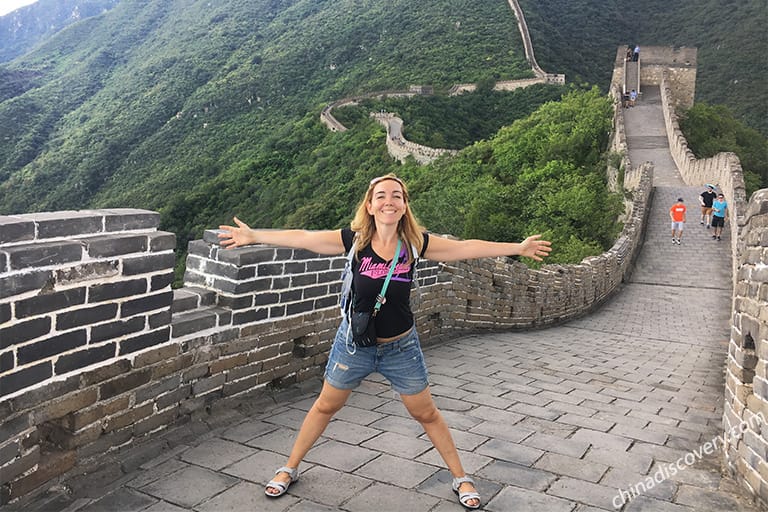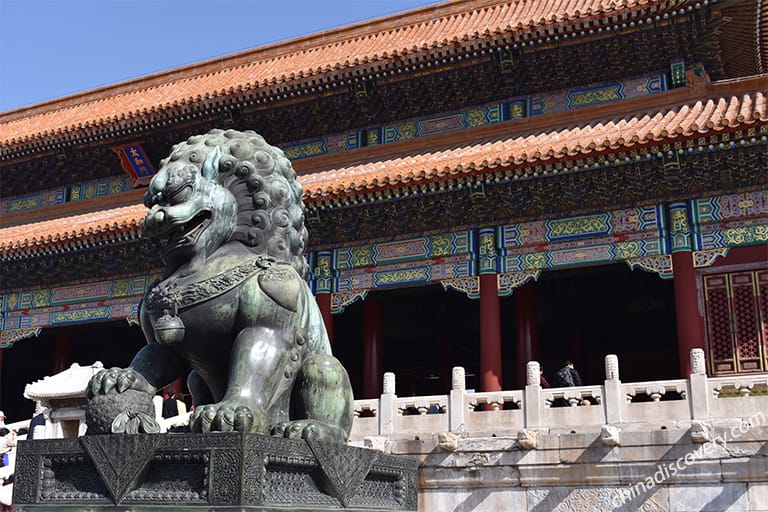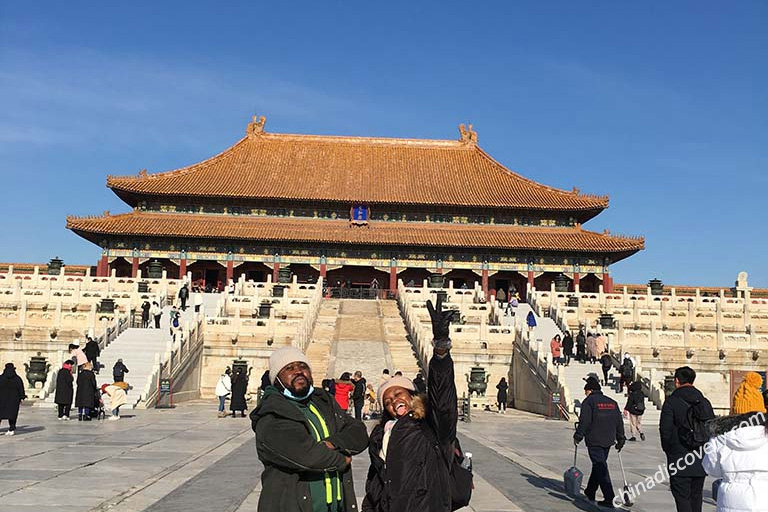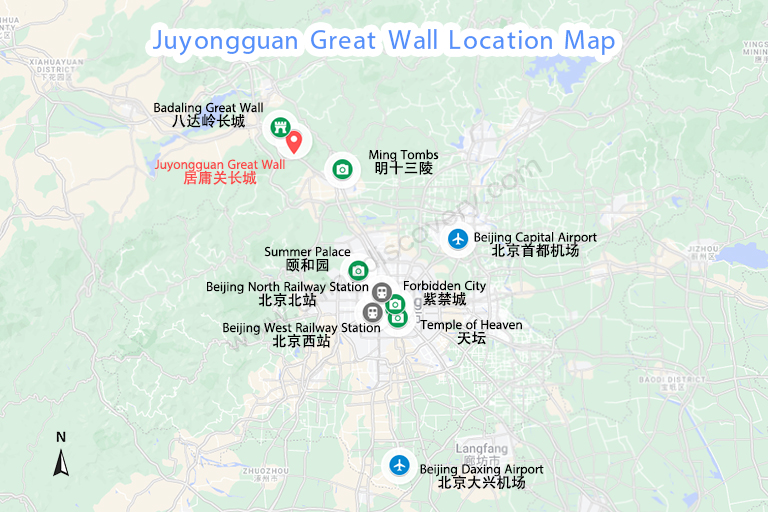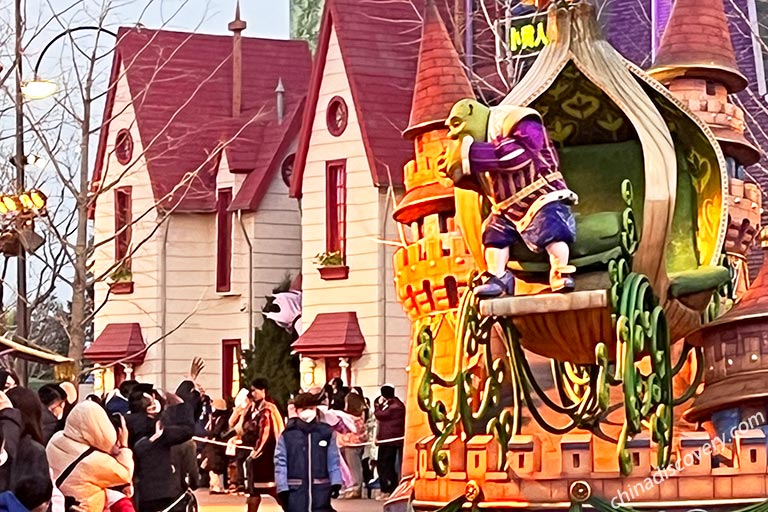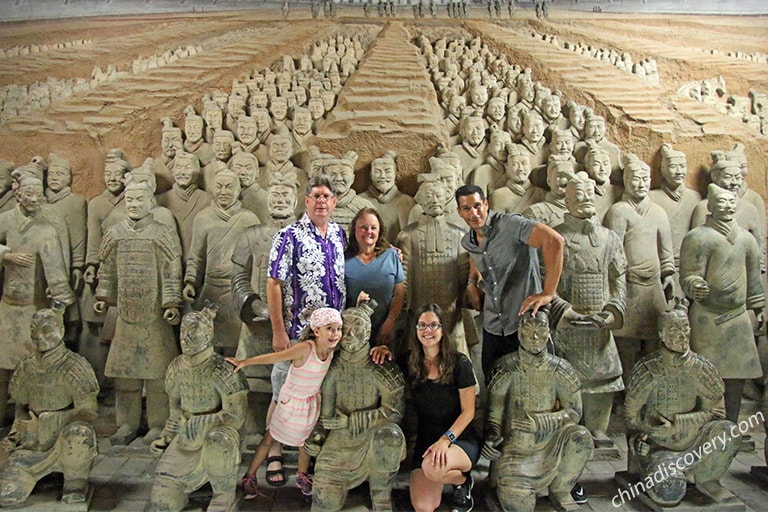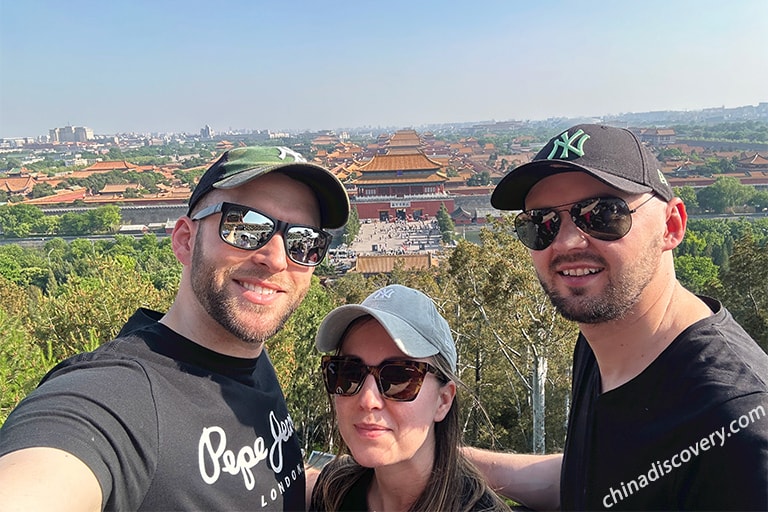History of Juyongguan Great Wall
Unlike a tourist attraction it is today, Juyongguan Great Wall in ancient China was built to defend Beijing. Juyongguan is the northern gateway to Beijing. It lies in the 18km Guangou Valley, endowing it with the natural advantage of being easy to hold but hard to attack. So it has been a must for military strategists since ancient times.
Actually the history of Juyong Pass can date back to The Spring and Autumn Period (770 B.C. – 476 B.C.). But it was not connected with the Great Wall until A.D. 556. During hundreds of years, Juyongguan witnessed many wars and change of dynasties. The Juyongguan we see today was built by General Xu Da in A.D. 1368 under the command of Zhu Yuanzhang, the first emperor of the Ming Dynasty (A.D. 1368-1644). Because after Zhu Yuanzhang overthrew the Yuan Dynasty, Emperor Huizong of Yuan fled to Shangdu (in today’s Inner Mongolia), planning to make a comeback and recover the lost land. Juyongguan is the place he must pass if he wanted to take over Beijing again, so it is necessary to strengthen the defense facilities of Juyongguan.
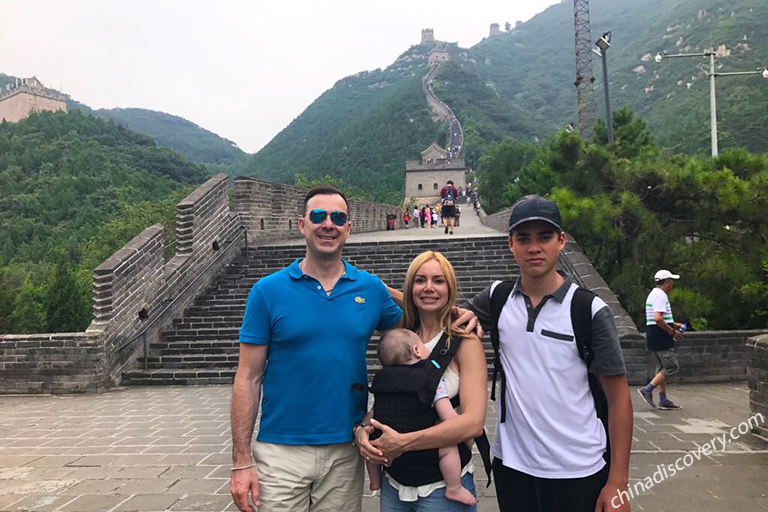 Juyongguan Great Wall
Juyongguan Great Wall
What to Do & See on Juyongguan Great Wall
Apart from the strategic significance, Juyongguan itself is rich in natural and cultural beauty. You can have a great view of the surrounding mountains, magnificent city towers, rolling watchtowers, and exquisite stone carvings while hiking.
Hiking the Great Wall
Needless to say, hiking is probably the top reason for tourists going to any section of the Great Wall. It is not only a great way to stretch your body, but also a good opportunity to enjoy the natural beauty. Located in a valley (Guangou), Juyongguan is surrounded by magnificent mountains with a clear river running through it. So don’t worry about the views, it is known as one of the eight famous scenic spots in Beijing since the Jin Dynasty (A.D.1115-1234).
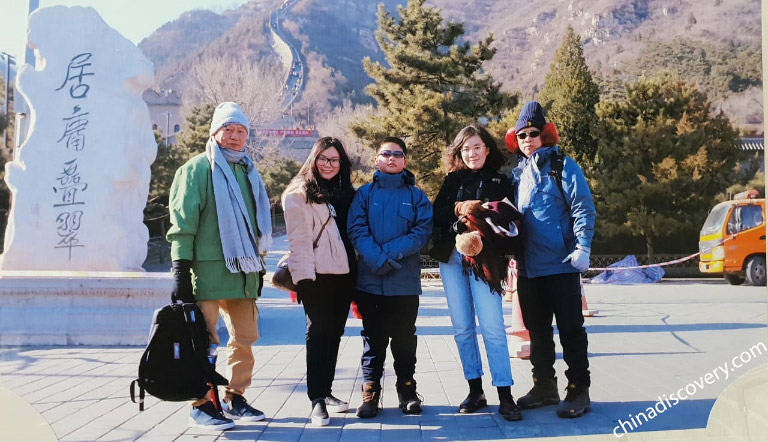 Our Guests from Indonesia Visiting Juyongguan Great Wall (2018)
Our Guests from Indonesia Visiting Juyongguan Great Wall (2018)
Appreciate the Precious Stone Carvings in Cloud Platform (云台)
At the center of Juyongguan stands a national treasure - cloud platform. It was built in A.D. 1345 by imperial command to be the base of the crossing street towers (three Lama Pagodas) with a passageway wide enough for pedestrians and carts to pass through. The towers have all long been destroyed, while the cloud platform stands still after nearly 700 years.
What make the cloud platform so valuable are the stone carvings of Buddhist images and inscriptions on the top of its semi-octagonal door and the inner walls and ceiling of the passageway. They are carved in the hope of bringing blessings on those who pass through the gate and protecting the country from misfortune. The central part of the door is carved with Garuda, accompanied by animal reliefs of different shapes. On the inner walls, there are images of the Four Heavenly Kings (four gods in Buddhism that guard the north, west, east, and south of the world) and their attendants, and the inscriptions from Buddhist text in six languages: Chinese, Sanskrit, Tibetan, Phags-pa language, Tangut language, and Old Uyghur language. On the ceiling engraves countless vivid Buddha reliefs and five mandalas. These carvings do not only show us the fine craft at that time, they are also a priceless treasure for historical study.
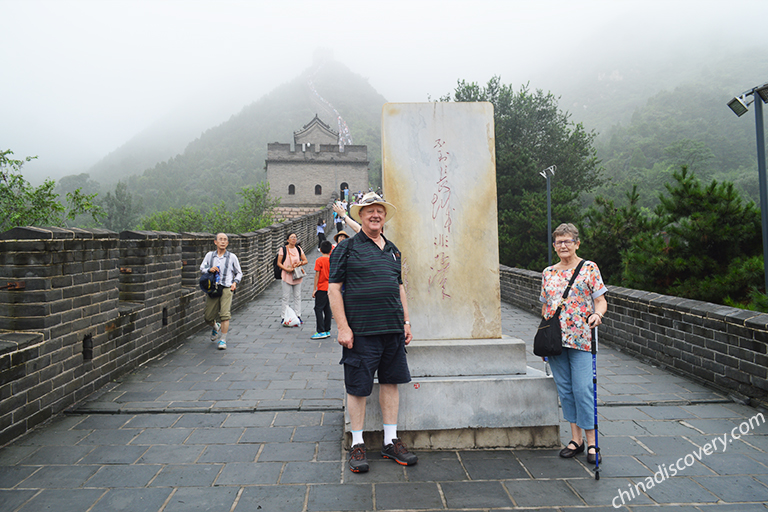 Juyongguan Great Wall
Juyongguan Great Wall
Grab a Sense of History from the Barbicans and City Towers
There are two city towers in Juyongguan, each of which is equipped with a Barbican. They are the defense lines of the capital city and have witnessed many wars in history. Once you get near juyongguan, you will see a board hung up high on the tower, saying “The Most Magnificent Pass in the World (天下第一雄关)”, which shows its status and importance in the past.
The barbican is in a horseshoe shape with fort barbettes on the top. You can still see several cannons there used in the Ming Dynasty (A.D. 1368-1644). The outer city wall is equipped with crenels and is taller than the inner wall, so that the soldiers can observe the conditions outside without exposing themselves. When in a battle, the barbican has another important usage - luring the enemies in. Once they are in the barbican, the city gate and barbican gate will both be closed. So the enemies are besieged and will soon find that there is no way out.
Find Different Kinds of Chinese Temples
Ancient Chinese people have a tradition of building temples to praise the meritorious people and worship the immortals for blessings. There are several distinctive Juyongguan temples you can visit during your trip such as the City God Temple (城隍庙), Luo Tong’s Memorial Temple (表忠祠), Horse God’s Temple (马神庙),etc.
City God Temple (城隍庙), built during the Hongwu period (A.D. 1368-1397) and rebuilt in 1765, is large in scale and at the central part of Juyongguan. Taoism believes that the City God can crack down the evil, protect people, and meet people's needs. It is believed to have the power of bringing rainfall in drought and sunny days when flood comes. So the temple was built here, wishing the country be prosperous and the people at peace.
Luo Tong’s Memorial Temple (表忠祠) is near watchtower 7. During the reign of Zhu Youcheng (A.D.1488-1505) in the Ming Dynasty, this temple was built to commemorate Luo Tong’s contributions. He was sent to defend Juyongguan in 1449. In October of the same year, Juyongguan was attacked by the Mongolian army (more than 30000 people) led by Yexian. Though much outnumbered, Luo Tong stayed calm, held the ground firmly, and took advantage of the cold weather. He ordered the soldiers to keep pouring water down the wall, so after a night, the stone city wall turned into an icy wall that was not climbable. Under the command of Luo Tong, Juyongguan was saved and so was the capital Beijing.
Horse God’s Temple (马神庙) is in the southwestern part of Juyongguan. This small temple was built in A.D. 1504, rebuilt in A.D. 1792 to worship the Horse God. It is the only Horse God’s Temple in Beijing. As we all know, battle horses are significant in a war in ancient times. Considering the defensive function of Juyongguan, it is not surprising that it was built here.
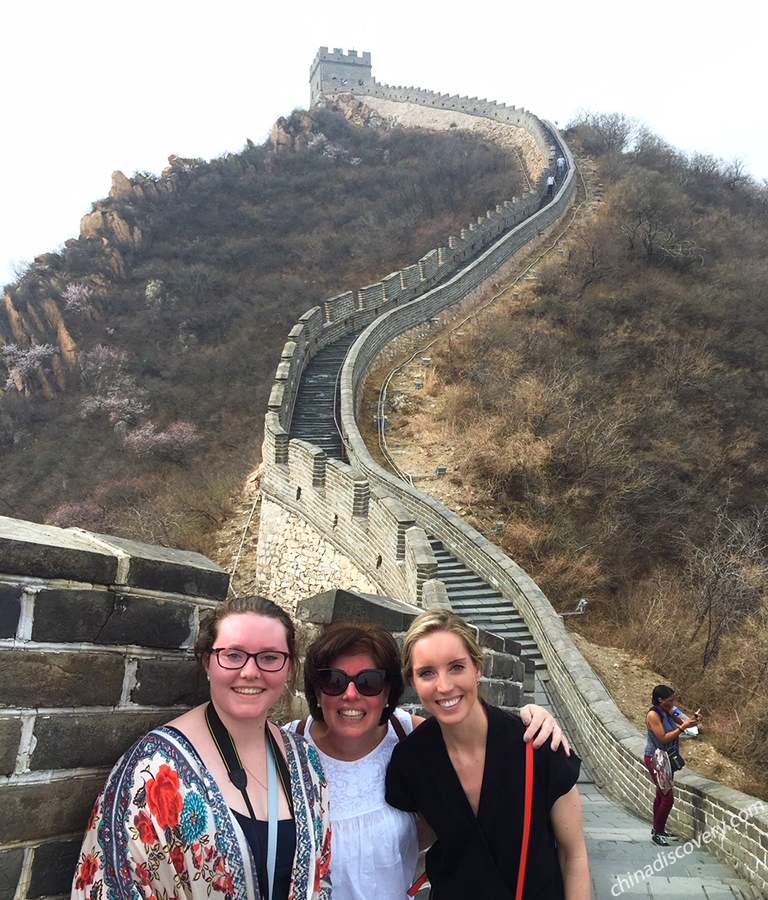 Juyongguan Great Wall
Juyongguan Great Wall
Visit a Special Spot of Juyongguan Great Wall - Water Gate (水门)
Apart from the mountains and broad views you can enjoy from most of the other sections of the Great Wall, there is a river running south-north in Juyongguan. So a Water Gate is built at the intersection of Juyongguan Great Wall and the river, near Watchtower 6, to control the amount of water for water storage and flood discharge.
The gate has two circular arched holes. There is a little tower on the gate with a sluice. In flood season, it opens to let the water out and in dry season, it closes to reserve river water for daily use in the pass. The piers of the water gate are pointy in the north and south to reduce the impact of flood on the water gate, so as to decrease damage and make it more endurable. The water gate and the river together form a scene that can not always be seen in other parts of the Great Wall.
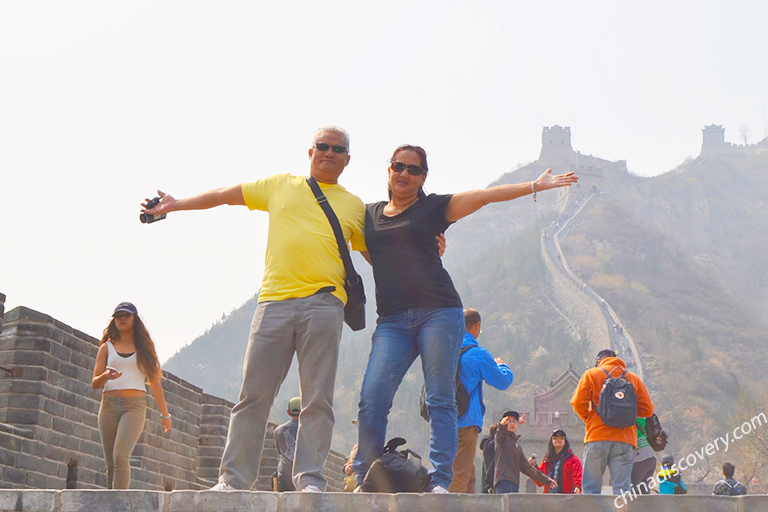 Juyongguan Great Wall
Juyongguan Great Wall
Recommended Route of Juyongguan Great Wall
Juyongguan Great Wall is a closed loop with a length of about 4km and is usually divided into the east part and west part by people. The relatively easy east part is from watchtower 1 to watchtower 6. Most people can finish this section of hiking in an hour. Here you can choose to descend the Great Wall or challenge the west part with steep and uneven steps. To finish the west part will need at least two hours and be prepared that you may have two sore feet the next day. So do remember to wear a pair of comfortable shoes. Of course if you just want to try the west part, you can start from watchtower 14 and descend at the south gate near watchtower 6.
>>Contact us to arrange a Juyongguan Great Wall Tour now
Where is Juyongguan Great Wall (Juyong Pass)
Juyongguan Great Wall is located in the northwestern part of Changping County, about 60 kilometers away from central Beijing (Tian’anmen Square). It is the closest section of Great Wall to downtown Beijing. Keep heading northwest about 15km, and then you will get to Badaling section of the Great Wall. Juyong Pass is a very important place connecting the capital Beijing and the northern border of China.
To Forbidden City: about 55km, 75 minutes' drive
To the Summer Palace: about 50km, 1 hour's drive
To the Temple of Heaven: about 65km, 1.5 hours' drive
To Beijing Hutongs: about 55km, 1 hour's drive
To Beijing Capital International Airport: about 75km, 75 minutes' drive
To Beijing Daxing International Airport: about 115km, 100 minutes' drive
To Beijing South Railway Station: about 70km, 75 minutes' drive
To Beijing West Railway Station: about 65km, 70 minutes' drive
How to Get to Juyongguan Great Wall
Though Juyongguan is the closest section of Great Wall from central Beijing (about 60km), it is still not very convenient to go there by public transportation or cab. Taking a bus or subway will take you about 2.5 hours.
Taking a Bus
1. Take Bus No.345 from Deshengmen (德胜门) and get off at Shahe Station (沙河站), then transfer to Bus No.68 to reach the scenic spot directly;
2. Take bus No.883 from Deshengmen and get off at Nankou East Street Station (南口东街), then transfer to bus No. 68 to reach the scenic spot directly.
3. Take bus No. 870, 883 or 919 from Deshengmen, get off at Changping South Exit (昌平南口), and transfer to bus No. 879 or Chang 20 to reach Juyongguan Great Wall.
Tips: You can also reach the Ming Tombs by taking bus No. 879 from Juyongguan.
Taking a Subway
Get off at Longze Station (龙泽站)on Metro Line 13 and take bus No.68 to the scenic spot
The transportation is for reference only, for it may change accoding to official arrangement. For more detailed informtaion about transportation of Juyongguan Great Wall, please check the offcial website.
Travel with China Discovery
If you want to remove all troubles and save your time, you can choose to travel with China Discovery. According to your own needs, we will customize a private tour for you covering all the transfer you need during the trip from the airport/train station to the hotel and the tourist attractions. In this way, you can travel worry-free with comfortable vehicle, skilled driver, and professional guide.
Best Time to Visit Juyongguan Great Wall
Generally speaking, Juyongguan is suitable to visit all year round, during which spring (March - April) and autumn (late September - November) are the most recommended. Because during this period, it’s neither too hot nor cold, you can appreciate the spring flowers and the colorful autumn forests with pleasant weather. But please try to avoid the National Day Holiday (October 1 - 7) because there will be too many crowds.
Attractions around Juyongguan Great Wall
Ming Tombs (明十三陵)
The Ming Tombs is about 20km (30 minutes’ drive) southeast of Juyongguan. Bus 879 will take you there in an hour. The Ming Tombs, covering an area of over 120 square kilometers, is the resting place of 13 emperors in the Ming Dynasty (A.D. 1368-1644). There is a 7km Sacred Way leading to the tombs with 12 stone animals lining up on each side. At present, only the Sacred Way, Changling Tomb, Dingling Tomb, and Zhaoling Tomb are open to the public. you can spend some time there when you go back to downtown Beijing from Juyongguan.>>Read More About the Ming Tombs
Badaling Great Wall (八达岭长城)
Badaling Great Wall is about 15km (30 minutes’ drive) northwest of Juyongguan. You can take the Tourist Bus Line 1 (旅游公交1线) mentioned above or Bus 879 to get there from Juyongguan. The bus trip will usually take about 1 hour. Badaling is another famous section of the Great Wall and is probably the most popular one. So if you want to cover both these sections in one trip, it is recommended to arrange them in two days. You can stay a night near Badaling and start hiking in the early morning to beat the crowds.>>Read More About Badaling Great Wall.
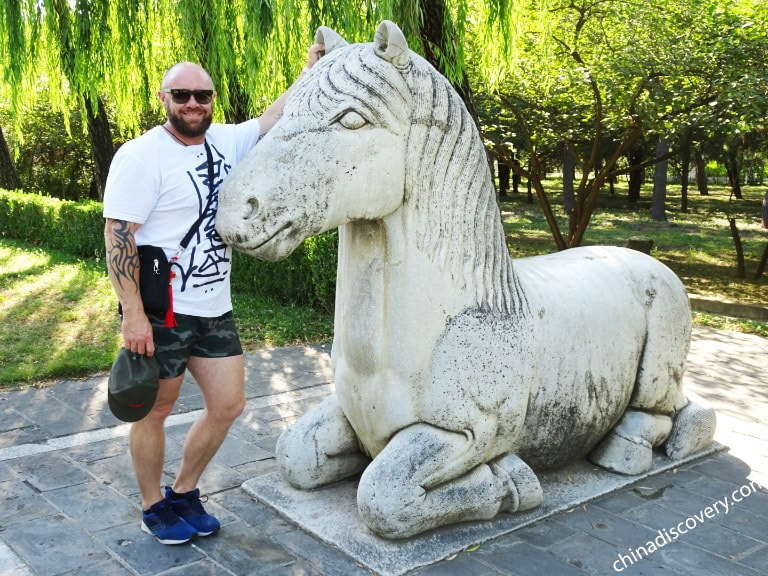 Our Guest Visiting Sacred Way at Ming Tomb (2019)
Our Guest Visiting Sacred Way at Ming Tomb (2019)
More Great Wall Experience besides Juyongguan
If you want to explore more marvelous great wall sections and admire picturesque nearby scenery, you're highly recommended to travel to Mutianyu Great Wall (慕田峪长城), so far the longest great wall in China. It is regarded as the "Essence of the Great Wall in the Ming Dynasty" with sublime architectural designs, intensive defensive towers, fascinating natural scenery, etc. With over 24,000 reviews and maintaining a 5-star rating, the Mutianyu Great Wall is consistently ranked as China’s No.1 Sight on TripAdvisor. Its stellar reviews and accolades make it a must-visit attraction.
Or if you want to admire stunning great wall in Beijing and don't know which sections of the Great Wall to pick, you're highly recommended to check Top 8 Best Sections of Great Wall to Visit.
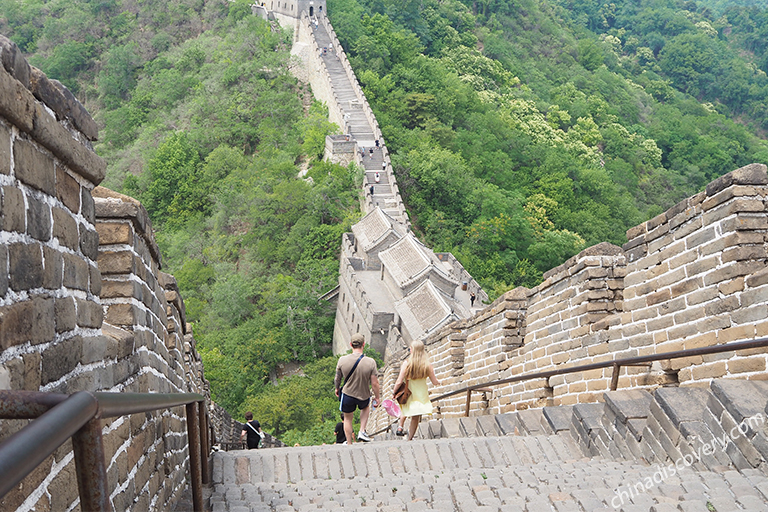 Mutianyu Great Wall
Mutianyu Great Wall
How to Plan a Juyongguan Great Wall Tour
There are many choices for you to take a Great Wall hiking tour. If you want to visit Juyongguan, you can start your trip at around 8:00 or earlier. Then spend about 3 or more hours on the Great Wall as you like. In this way, you will be able to return to downtown Beijing in the afternoon. Usually the Great Wall is just one part of a Beijing tour. To better explore this ancient city, you are recommended to spend about two more days to visit Tiananmen Square, now the largest city plaza in the world, one of the world’s five most important palaces – the Forbidden City, the largest and best-preserved royal garden in China Summer Palace, and experience the typical Beijing Hutongs.
☛ 4 Days Classic Beijing Tour Package (include Mutianyu Great Wall)
☛ 4 Days Beijing Highlights Tour with Gubeikou to Jinshanling Great Wall Hiking
☛ 6 Days Classic Beijing Tour with In-depth Great Wall Experience (include Jinshanling Great Wall)
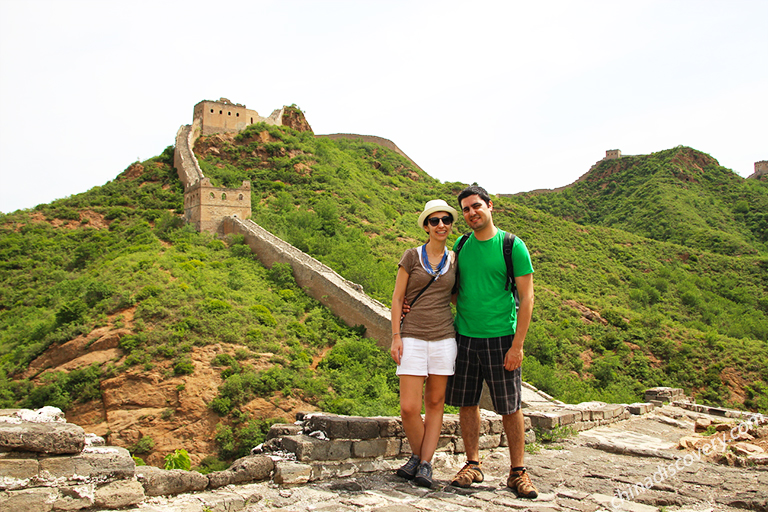 Our Delighted Guests in the Great Wall
Our Delighted Guests in the Great Wall
As the most popular transportation hub in China, you can easily travel from Beijing to any other hot travel destinations in China by flight or train, such as Xian, Shanghai, Yangtze River, Guilin, Chengdu, Tibet and other popular destinations in China by flight or train... China Discovery has designed many great China tour packages from Beijing for you. Please make your choice from our collections or let us customize one for you.
☛ 5 Days Beijing Xian Highlights Tour by High Speed Train
☛ 6 Days Classic Beijing Xian High-speed Train Tour
☛ 12 Days Wonders of China Tour (Beijing, Xian, Guilin, Zhangjiajie & Shanghai)
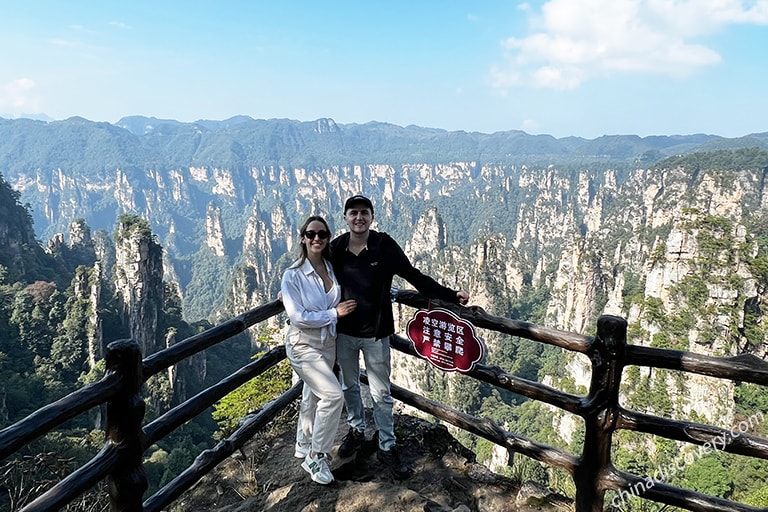 Our Delighted Guests in Zhangjiajie
Our Delighted Guests in Zhangjiajie
If you have any other questions or ideas, please feel free to contact us. Our professional travel consultants are always ready to help!
Keep Reading About Beijing Attractions
- Great Wall of China
- Mutianyu Great Wall
- Jinshanling Great Wall
- Forbidden City
- Summer Palace
- Temple of Heaven
- Tiananmen Square
- 798 Art District
- Jingshan Park
- Beijing Hutong
- National Museum of China
- Gubei Water Town
- Lama Temple
- Yandaixie Street
- Nanluoguxiang
- Beijing Central Axis
- Beijing Olympic Park
- Old Summer Palace
- Badaling Great Wall
- Huanghuacheng Great Wall
- Simatai Great Wall
Top Beijing Tours & Travel Guide
- Forbidden City Tours
- Popular Beijing Tours
- Great Wall Hiking Tours
- Beijing Visa Free Tours
- Beijing Layover Tours
- Tpo 6 Beijing Vacations
- Beijing Family Tours
- Beijing Travel Guide
- Beijing Travel Articles
- Great Wall Trip Planning Guide
- How to Plan a Beijing Trip
- Things to do in Beijing
- Top Experiences Recommended by LP
- Featured Activities in Beijing
- How to Get to & around Beijing
- Weather & Seasons in Beijing
- Beijing Maps
- Beijing 144/24 Hour Visa Free
- Recommended Hotels in Beijing
- Beijing Photo Gallery
- Top Beijing Food and Snacks
- Beijing Shopping
- Beijing Nightlife
- Beijing FAQs & Tips
- Forbidden City Travel Tips
- Forbidden City Facts
- Forbidden City Map
- Hall of Supreme Harmony
- Imperial Garden
- Nine-dragon Screen
- The Gallery of Clocks
- The Treasure Gallery
- Palace Museum Collections
- How to Visit the Forbidden City
- Forbidden City Photography Tips
- Forbidden City Weather & Seasons
- How to Book Forbidden City Tickets
- How to Get to Forbidden City
- How to Transfer from Beijing Airports
Recommended Beijing Tours
Top 3 Beijing tours chosen by most customers to explore Beijing in the best way. Check the detailed itinerary, or tailor your own trip now with us.

8 Days Best of China Tour (Flight/Bullet Train Covered)
Beijing / Xian / Shanghai
Start planning your tailor-made holiday to China by contacting one of our specialists. Once inquired, you’ll get a response within 0.5~23.5 hours.
Customize a TripHave a question? Get answers from our travel experts or guests
- Your Question:
- Your Name:
- Your Email:
- Submit


























